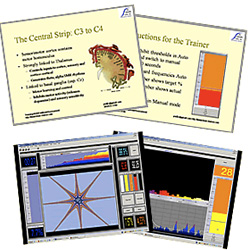Autism
There are many people working with autism in its various forms who use the TQ. You’re talking about brains which are extremely disorganized. Certainly, coherence and timing issues are part of that problem, and perhaps I’m not up to date here, but I’m not aware of any research that indicates that front/back connectivity is a greater or more basic problem than any of the many others involved.
Many folks who work with autistic spectrum who don’t do any assessment to get started: they use tried-and-true recipes—mostly bipolar—to start creating an area of improved function in the brain from which they can start building. These can be very helpful in providing the client with improved control over the screening functions that are usually the most basic issue. Doing a TQ can be very helpful after the initial layer of difficulty has begun to respond. Keep in mind that with a general brain problem like autism, worrying about specific behaviors is probably a waste of time. As the brain gains greater control and stabilizes, behaviors will go away.
HEG
HEG is usually the simplest to start with. Have the family start the client practicing wearing a baseball cap around the house. I use the one with the adjustable size, starting with a very loose headband. He wears it 2-3 times a day for a minute or two and works up. The HEG headband is pretty easy after that and takes almost no time to put on–or re-apply. This will be much easier for a sensory-defensive young person to get accustomed to, no prepping or sticking electrodes on with paste. It will help to get the prefrontal activated, and improving executive functions (such as screening sensory inputs and motor outputs) will be an important first step.

If you do wish to do EEG, Mark Darling, who has worked a good deal with young people in this population, has written that a bipolar 1-channel hookup at T4/P4 would be a good place to start. You will inhibit 2-5 Hz and 19-38 Hz and reward starting perhaps around 12-16, sliding that band down until you get some kind of response. If you haven’t seen the video Training ADHD without an assessment, you may find that helpful, as ASD is a very extreme Filtering problem–at least the first few layers.
High fast wave coherence in the back of the head is also a common finding in autism, where sensory defensiveness is often an issue.
Asperger’s clients often seem more to use the blocking strategy, the obsessive and compulsive characteristics, than this dissociative one, but I’ve only worked with maybe a half-dozen of them.
This population, with Tourettes, PDD and closed head injuries, among others, has always seemed to me to cry out for a home-based machine. When the sessions can be done at home, length is less of an object and the client can do literally hundreds of sessions over years, which is often how the really astounding improvements come about.